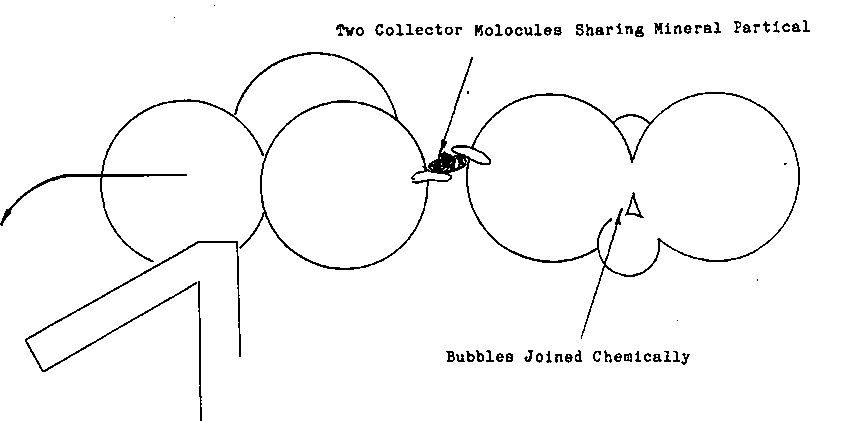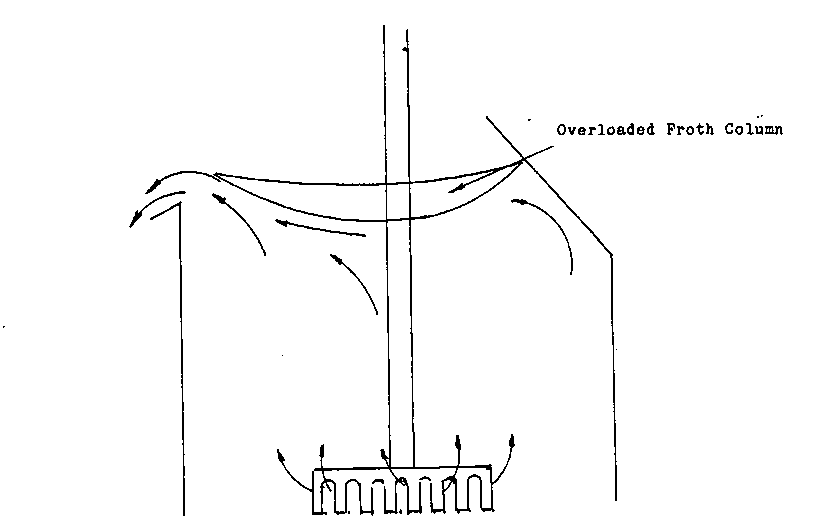Any time that you have an overloaded froth condition the OVERFLOW that is going over the side of the cell will slow down as the froth column begins to collapse under the weight of the mineral. The first corrective reaction is to raise the pulp level or add air to the cells to quickly increase the overflow. As a band aid solution this is correct, but as the ultimate correction it is not. The purpose of the air is to provide the medium that the collector attaches and to provide a surface for the mineral to be floated away on. You should only use enough to accomplish this, too much air will cause a loss of recovery in two ways. First in the form of surface agitation of the pulp, this will dislodge much of the mineral that is floating near the bottom of the froth column either by breaking the bubble it is floating on or simply because the lower particles of mineral are not held firmly enough by the collector. If it is picked up again by the froth it will be farther along in the circuit where there will be less retention time. If the agitation is severe and there is a lot of mineral being dislodged, an over load or mineral loss may result due to the lack of cell space for the mineral.
Either band aid method will be costly due to the loss of efficiency of the froth column, raising the pulp level to speed the over flow of the froth will increase retention time but decrease the froth column. This will lessen the time that the poorly mineralized particles has to filter out of the froth. Adding air temporarily lessens the froth column “by taking up space in the float cell. Until the pulp level has had a chance to equalize to its pre-set level the froth column will be shallower. Once the slurry is back to its operating level the extra air that was added to the cell is taking up space, this of course will cause the speed that the pulp flows through the cell to increase lowering the effectiveness of the process.
If you watch the FROTH as it comes over the edge of the float cell you will notice as each bubble flows over the edge, the bubbles behind it will move to the front of the cell.
This is because as the bubble moves forward the bubble behind is attached to the front bubble by collector molecules that are attached to common particles of mineral. As a froth column over loads this attraction is not strong enough to keep the bubbles joined together. The surface movement of the froth will deteriorate until only the front portion is moving.
At this point a little extra frother and air will give the collector molecules more surface area to attach themselves to. The extra bubble surface will let the trapped impurities filter through the froth easier. This will help clean the impurities out of the concentrate and lower the load of the froth column.
As you have probably guessed by now, a single cell isn’t the full extent of the separation process. In the most basic of circuits, there will be a line of individual cells each taking the pulp from the one that was before it. The slurry flows through this line of cells until all the mineral that is economically feasible to recover has been retrieved. Let’s look at this for the whole flotation bank now.
One of the things to remember, with these cells, is that whatever change is made to each individual cell will affect the remaining cells in that bank of cells. This means add a little air to the first impellor to pull it a little harder and the last cell will begin to move faster as the load is removed. Also if you increase or decrease the air for one impellor the speed of the froth being discharged from the cell in front of and behind will change as well. To
operate these cells correctly you have to have them balanced to allow the entire surface area of the cell bank to pull evenly.


